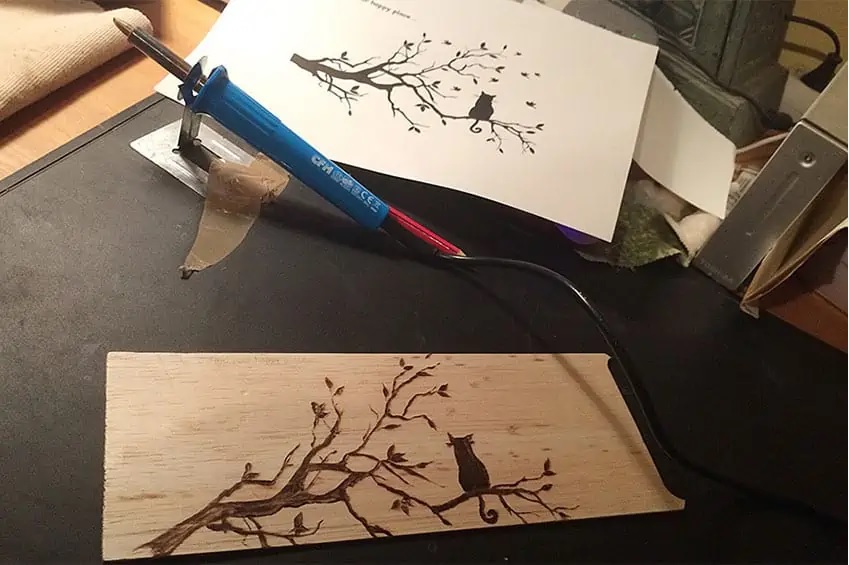Pyrography Art- A Unique and Time-Honored Art Form
Anyone who loves art knows there are countless styles, mediums, and theme combinations out there. Each piece is unique and special in its own way. But of all the art styles, Pyrography art is perhaps one of the most stunning and unique of them all.
Pyrography, also known as pyrogravure, is the art form of decorating wood or other materials with heat or flame. In this one-of-a-kind art form, artists make their designs with burn marks from specialized tools that are heated to burn wood in the desired pattern or design. Pyrography art can also be called pokerwork or wood burning.
The term Pyrography means “writing with fire”, from the Greek pur (fire) and graphos (writing).
Common items decorated with pyrography designs include cups, wood blocks, bowls, chests, plates, decorations, furniture, and wall art. Pyrography art can take the form of simple open-line sketches or complicated images with shadows and shading. A range of materials can be used, with wood being the most common, and customizable applicators and tools allow for an array of effects.

History of Pyrography Art
It is believed that this art form dates back to prehistory and may well be one of the first to arise after mankind began putting paint on cave walls. When early humans learned that charcoal from fires could be used to create images and that fire left behind marks, that may well have been the first examples of Pyrography art.
We know the art form existed in China since the time of the Han dynasty, where it was known as “Fire Needle Embroidery”.Pyrography has endured to this day and is a treasured and respected form of traditional folk art in many parts of Europe and South America. Artistic hot spots for Pyrography art include Romania, Poland, Hungary, Argentina, and other neighboring countries.
Equipment Used
Traditional Pyrography art can be created with any heated metal implement or application of controlled burning. Modern pyrography machines are very innovative and versatile. These customized tools can include any variation of the following three basic types:
Solid-point burners
These burners come with a solid brass tip which is heated through an electrical element in the tip and operates at on single controlled temperature.
Wire-nib burners
These burners are more versatile as they have variable temperature controls and some models have interchangeable nibs to generate a range of burn effects.
Laser cutters
Many laser cutters provide use software to burn uploaded designs and drawings as a way to transfer them onto a sheet of wood and create a piece of art.
Wood Medium Options
As a common medium for artwork, wood can be used in a number of different ways, depending on specific qualities and the type of art being made. Wood in general, can differ in hardness, grain, figure, texture, color, and other physical characteristics. Pyrography art uses a number of these features to generate a range of finished looks.
Hardness
All woods are broken down into either hard or soft classifications. Usually, softwoods are needle-bearing trees like pine and spruce. Hardwoods are from broad-leaved trees like oak and maple. Softwood lives up to its name and is softer and easier to burn than hardwoods.
Grain
The direction of the interior woody cells of the tree is called the grain. When sanding wood to prepare for Pyrography art, it is essential to sand with the grain to avoid roughing it up even more. The grain can also significantly impact the burn lines and final Pyrography design.
Figure
This term refers to the natural design, or pattern apparent in the grain of the wood. The figure present on the wood is a key part of the medium and should be incorporated as much as possible when you are planning a design. Some really cool effects can be created this way.
Texture
There is a texture to the fibrous cells that make up the wood. When making Pyrography art, it is the texture on the surface of that wood that is most important. It can feel either coarse or fine, even or uneven, and it affects how the heat moves through the wood.
Pyrography artists typically avoid doing overly complicated or intricate designs on uneven, coarse-textured wood. Larger pieces also lend themselves to more complex works as there is more space and more variation between burned and non-burned areas.
Pyrography Art in the Market Today
If you are interested in this unique art form and want to find some stunning pieces for your home, Artblok is a great place to check. Our marketplace has art from a number of artists and features many amazing styles and mediums. Check for Pyrography art or any other fantastic artwork you might be in the mood for. Who knows what you will find at Artblok!